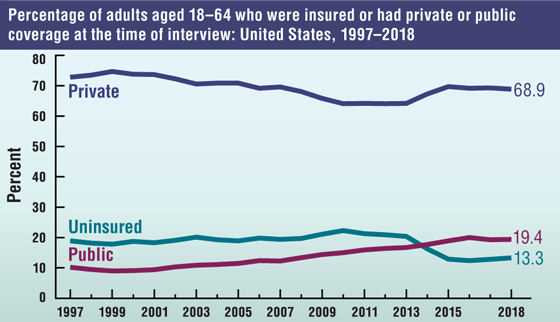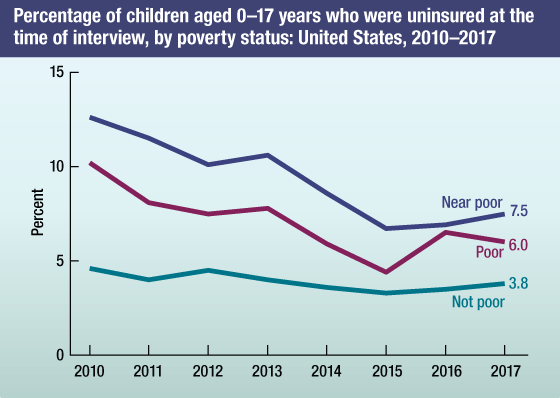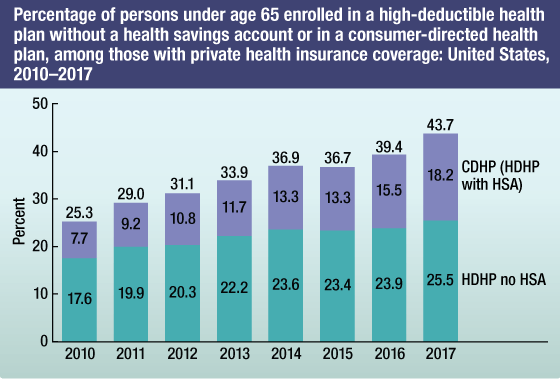NCHS Health Insurance Data
NCHS Fact Sheet, July 2018
PDF Version pdf icon[PDF – 249 KB]
About NCHS
The National Center for Health Statistics (NCHS) is the nation’s principal health statistics agency, providing data to identify and address health issues. NCHS compiles statistical information to help guide public health and health policy decisions.
Collaborating with other public and private health partners, NCHS uses a variety of data collection mechanisms to obtain accurate information from multiple sources. This process provides a broad perspective on the population’s health, influences on health, and health outcomes.
Health insurance
Health insurance coverage is an important determinant of access to health care and health status. Uninsured children and nonelderly adults are substantially less likely than their insured counterparts to have a usual source of health care or a recent health care visit. The major source of coverage for persons under age 65 is private employer-sponsored group health insurance. Individual and family private health insurance coverage can also be purchased either directly or through the Health Insurance Marketplace or state-based exchanges. Public programs, such as Medicaid and the Children’s Health Insurance Program, provide coverage for many low-income children and adults.
To develop policies and programs that improve health insurance coverage, obtaining timely and accurate information on the number of persons who lack health insurance coverage and the number of persons with different types of coverage is important.
Health insurance data
The National Health Interview Survey (NHIS) has been collecting comprehensive data on health insurance coverage since 1959. Three estimates of lack of health insurance coverage are provided quarterly: uninsured at the time of interview, uninsured at least part of the year prior to interview, and uninsured for more than a year at the time of interview. Data are also provided on public and private coverage for those currently insured, including data on enrollment through the Health Insurance Marketplace, through state-based exchanges, and in high-deductible health plans. For 2017, NHIS reported state-specific health insurance estimates for 18 selected states for persons of all ages, persons under age 65, adults aged 18−64, and children aged 0–17.
NHIS findings in 2017 show:
- In 2017, 29.3 million persons of all ages (9.1%) were uninsured at the time of interview—not significantly different from 2016 but 19.3 million fewer persons than in 2010.
- Among adults aged 18–64, 69.3% (136.6 million) were covered by private health insurance plans at the time of interview.
- The percentage of adults aged 18–64 who were uninsured at the time of interview decreased from 22.3% in 2010 to 12.8% in 2017.
- In 2017, the percentage of adults aged 18–64 who were uninsured at the time of interview varied by state. For example, 5.4% were uninsured in Massachusetts compared with 26.4% in Texas.
 image icon
image icon
NOTE: Data are based on household interviews of a sample of the civilian noninstutionalized population.
SOURCE: NCHS, National Health Interview Survey, 2017, Family Core component.
NHIS data on health insurance coverage for children show:
- Among children, 6.0% of poor, 7.5% of near-poor, and 3.8% of not-poor children did not have health insurance at the time of interview in 2017.
- The percentage of near-poor children without health insurance at the time of interview decreased from 22.8% in 1997 to 7.5% in 2017.
- The percentage of poor children without health insurance at the time of interview decreased from 22.4% in 1997 to 6.0% in 2017.
 image icon
image icon
NOTE: Data are based on household interviews of a sample of the civilian noninstitutionalized population.
SOURCE: NCHS, National Health Interview Survey, 2010–2017, Family Core component.
High-deductible and consumer-directed health plans
NHIS provides estimates of enrollments in high-deductible health plans (HDHPs) and consumer-directed health plans (CDHPs).
- In 2017, 43.7% of persons under age 65 with private health insurance were enrolled in an HDHP, including 18.2% who were enrolled in a CDHP (an HDHP with a health savings account [HSA]) and 25.5% who were enrolled in an HDHP without an HSA.
- Among persons with private health insurance, enrollment in HDHPs has increased 18.4 percentage points, from 25.3% in 2010 to 43.7% in 2017.
- More recently, the percentage of those enrolled in an HDHP increased from 39.4% in 2016 to 43.7% in 2017.
 image icon
image icon
NOTES: CDHP is consumer-directed health plan, which is a high-deductible health plan (HDHP) with a health savings account (HSA). HDHP no HSA is a high-deductible health plan without an HSA . The individual components of HDHPs may not add up to the total due to rounding. Data are based on household interviews of a sample of the civilian noninstitutionalized population.
SOURCE: NCHS, National Health Interview Survey, 2010–2017, Family Core component.
Health insurance data source
NHIS collects information on the health of the U.S. civilian noninstitutionalized population through personal household interviews. It measures health status and disability, selected conditions, insurance coverage, access to care, use of health services, immunizations, health behaviors, injury, and the ability to perform daily activities.
For more information about NCHS, visit https://www.cdc.gov/nchs.
For more information about NHIS, visit https://www.cdc.gov/nchs/nhis.htm.